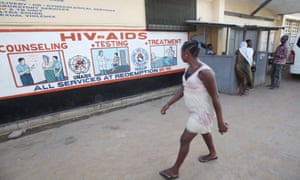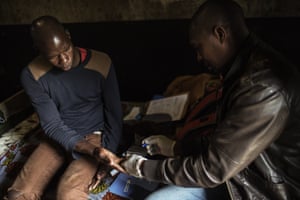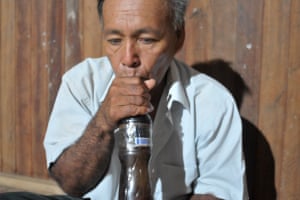Senate Democrats have called for Congress to end its recess and immediately approve emergency funds for combating the Zika virus in America, after Florida reported its first cases of mosquito-borne infections on the mainland, and funding for mosquito nets for pregnant women started running low.
Near downtown Miami, teams of doctors were going door to door on Saturday to alert an estimated 30,000 residents, particularly pregnant women, of the risks of being bitten by local mosquitoes believed to be carrying the virus.
On Friday, Florida governor Rick Scott and the federal Centers for Disease Control and Prevention (CDC) confirmed that four new cases of the disease in the Miami area were almost certainly contracted through local insect bites. CDC director Tom Frieden warned: “Zika is here now.”
Testing of mosquitoes in the area has not produced a positive result for Zika so far, Scott said, but the authorities believe that is the most likely explanation for how the latest infections had occurred.
Florida Senator Bill Nelson and Senate minority leader Harry Reid then demanded that Congress reconvene and release emergency funding, which lawmakers had failed to approve amid bitter infighting. They then left the matter unresolved for a seven-week recess that began in June, coinciding with the start of the peak months for North American mosquitos.
“If there was ever a time for Congress to act it is now,” Nelson wrote in a letter to the majority leader, Republican Mitch McConnell, on Friday, calling on him to reconvene the Senate.
Reid called on both houses of Congress to reconvene. Then he added on Twitter that: “Americans can’t afford to wait until Congress’ vacation is over.”
The vast majority of the more than 1,600 cases of Zika previously reported by the CDC within the US were contracted while patients were traveling abroad or, in a small number of cases, through sexual transmission after entering the US. In the US commonwealth of Puerto Rico, there are thousands of mosquito-borne infections, in what Frieden called a “silent epidemic” that could threaten the mainland.
Dr Aileen Marty was one of more than 80 doctors and health officials going house to house in the affected area in Miami-Dade and Broward counties in Florida on Friday, asking residents questions and offering testing for the virus.
“The goal is to get to every single household in this area and talk to them about eliminating mosquitoes, asking questions, answering questions and if there is a pregnant women in the house, giving her special advice,” she said.
Marty is professor of infectious diseases at Florida International University and has worked as an expert in, among other disciplines, tropical diseases and disaster medicine for the federal government, the US military and international organizations, for instance with the WHO in Nigeria during the Ebola epidemic in 2014.
“We need everyone doing the right thing so we can squish this immediately,” she said.
Marty added that Florida had had success in quickly jumping on local outbreaks of mosquito-borne dengue fever and chikungunya in the past, and she was confident that state and local officials would do the same with Zika.
She said the area where the locally transmitted cases have been found, close to the center of Miami, was “a pretty dense area”.
“It’s an arts district, lots of tourists in the evening, which is of concern to us as well,” she said.
The Zika virus is carried by female mosquitoes of the Aedes species: principally Aedes albopictus and Aedes aegypti, which are active during the day. Together the species have a wide range around the US, as far north as Maine and Minnesota and as far west as northern California.
Marty said the relevant mosquitoes operate within a small radius of around 900 to 1,500ft of where they hatch, though they can be carried on the wind.
“To find Zika in a mosquito is very difficult,” Marty said. “Not finding one does not mean Zika is not there. You have to get really lucky, there are a lot of mosquitoes and most hatch fine, then there will be one family of insects that gets infected.”
She said the Aedes species is “sneaky” and does not bite one person and lays eggs, but takes “little nibbles” out of five or six people in obscure places, “like behind your elbow”, a female lays eggs.
The Florida and federal authorities have warned people in Miami to use mosquito repellent when going outside.
Marty and other doctors in the rapid response teams that have been distributing Zika prevention kits to households, in particular giving mosquito nets to homes where a woman is pregnant or thinks she is pregnant.
“But we may run out of funds on the nets,” she said.
She was unable to provide details of how funding is decided for such resources. “Mosquito nets are being issued,” she said. “They are only being given to families with pregnant women, but the funding might run out for them.”
When asked whether pregnant women she was encountering in the affected area were scared, she said: “Of course they are. Wouldn’t you be? They want to know what their risks are.”
Contracting the Zika virus during pregnancy, especially early on, brings the risk of fetal brain malformation, especially microcephaly.
Marty reassured women in the affected area that action was being taken and their chances of being infected with the Zika virus via local mosquitoes were currently “slim to none”.
A spokeswoman for the governor said details of Zika funds were being handled by Florida’s department of health. A spokeswoman for the department sent a statement to the Guardian, saying: “the Governor has committed $ 26.2m in state funding to preparing for and responding to Zika. We have no shortage of Zika prevention kits.”
The CDC has not recommended that pregnant women leave the Miami area or refrain from traveling to that area.
But Dr Peter Hotez, dean of the National School of Tropical Medicine, at Baylor University in Waco, Texas, disagreed with that assessment.
“In Miami if you are pregnant or you might be pregnant, limit your time outdoors. Use air conditioning and if you are going out, consult your OB-GYN,” he said.
Hotez also warned that during the peak mosquito season of July, August and September, “if you are pregnant or you think you might be pregnant, avoid travel to the Miami area. You now have to treat Miami like Puerto Rico or Brazil or Honduras. That’s my opinion – but CDC is not willing to go that far yet.”
Hotez said the Aedes species is particularly successful in cities, and infected people arriving from the Caribbean and Latin America, especially through ports such as Houston or New Orleans, could be at risk for infection and as hosts for infected eggs.
The CDC has warned of the prospect of Zika outbreaks along the southern, coastal US this summer.
Hotez called Congress’ refusal to approve federal funding “outrageous”.
A compromise bill to provide $ 1.1bn in funding, below the $ 1.9bn that the White House has requested, had been close to approval but was blocked by Senate Democrats after House Republicans returned it with unrelated provisions about abortion restrictions, overturning environmental and health regulations, and scuppering bans on the Confederate flag. Senator Bill Nelson condemned the attachments as “poison pills” that doomed the legislation.
Republican Senator Marco Rubio has broken with his party on the issue, and on Friday tweeted a demand for funding from the Obama administration. His office also released a statement that said he has warned of the risk of local transmission of Zika “for months” and that “sadly that has now become a reality”.
The CDC’s Frieden warned that the US has “an unprecedented health threat”.
But Hotez made a more specific, pointed warning. “There is no margin for error,” he said. “If we start seeing babies with microcephaly seven, eight or nine months from now in Miami that will be unacceptable.”
Democrats demand Congress end its vacation to approve Zika funding











